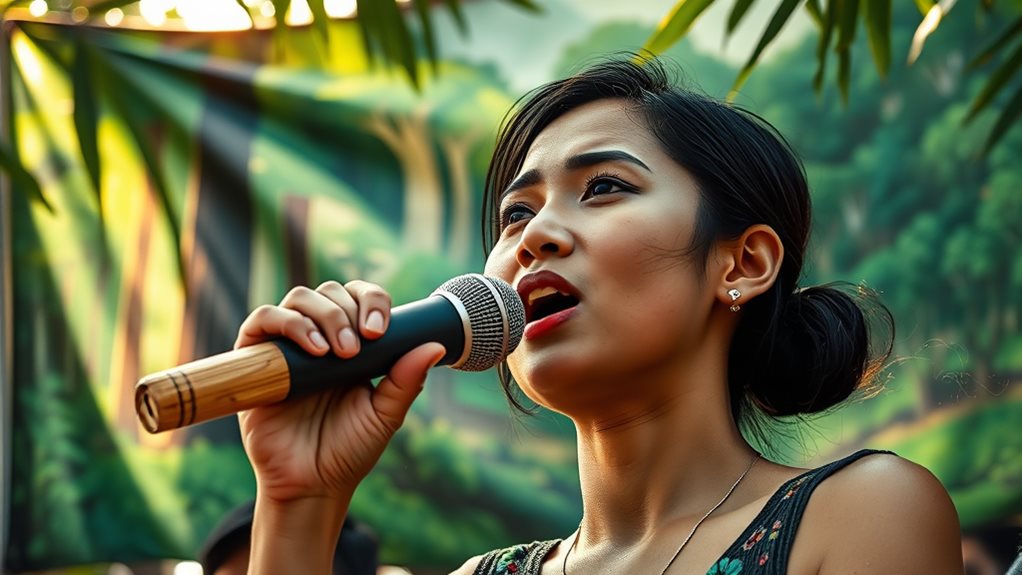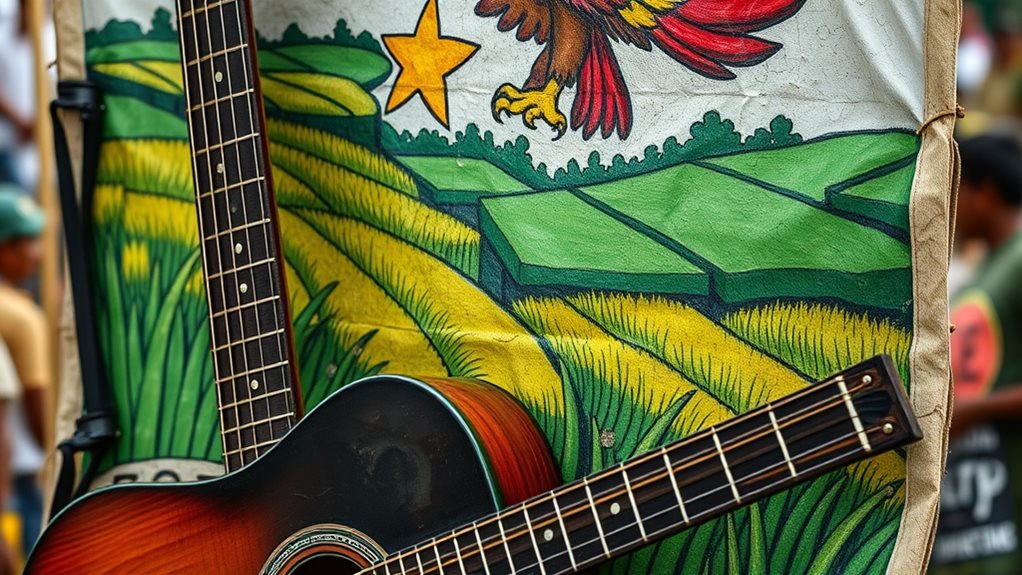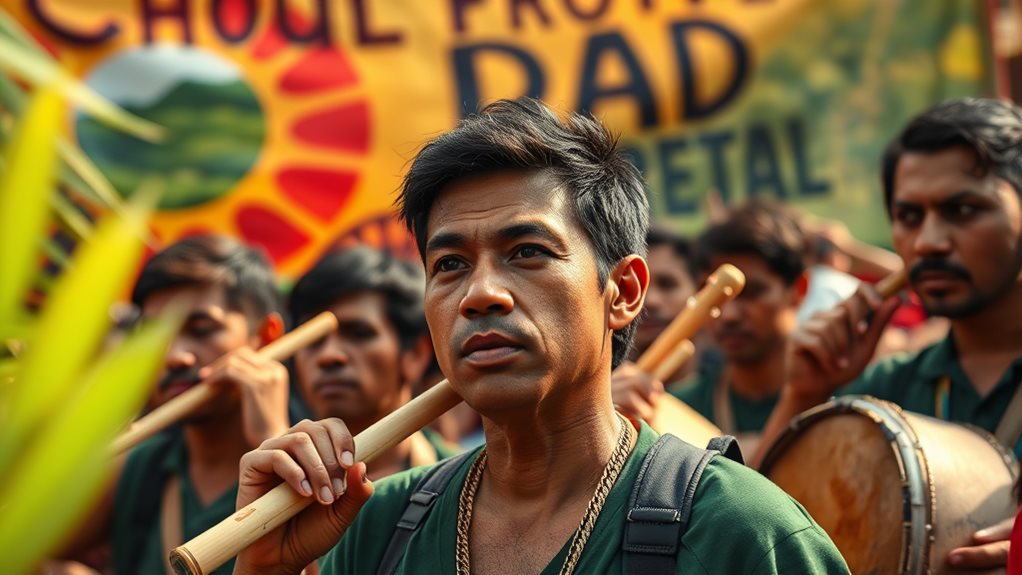Music plays a vital role in Filipino environmental movements**. It inspires action and broadens the appeal of activism through various genres. For instance, K-pop fans have initiated tree-planting projects**, while the Department of Environment and Natural Resources (DENR) released the "KANTALIKASAN" album, which promotes environmental awareness through music.
Indigenous music preserves cultural knowledge and fosters community solidarity**** in the face of environmental threats. It helps to document the cultural significance of natural resources and promotes collective action to protect them. For example, the indigenous Ifugao people of the Philippines use traditional songs and dances to teach younger generations about sustainable forest management.
Protest songs amplify marginalized voices and document environmental injustices****. They raise awareness about environmental issues and mobilize people to take action. For instance, the song "Tinikling" by Filipino artist Joey Ayala highlights the struggles of indigenous peoples against mining and logging in their ancestral lands.
The combination of music and activism has significantly impacted environmental campaigns in the Philippines. It has helped to raise awareness, mobilize communities, and influence policy decisions. By using music as a tool for environmental activism, Filipinos have been able to create a more inclusive and effective environmental movement.
Music's Advocacy Power

Music's ability to inspire environmental action in the Philippines is undeniable. Songs like "Masdan Ang Bukas Ko" carry melodic messages, fostering intergenerational dialogue on nature preservation****. The use of genres like bossanovarumba ensures broad appeal, maximizing the reach of these harmonious activism efforts.
Environmental advocacy songs often begin with recognizing environmental issues, transforming that awareness into action through music's power. Music's effectiveness stems from its ability to connect with a vast audience and evoke strong emotions.
K-pop fans' involvement in tree-planting initiatives and Earth Hour participation demonstrates music's impact. Fan communities, like Army Bayanihan, collaborate with organizations such as Greenpeace Philippines, raising funds and awareness for environmental projects.
Globally, K-pop fans' collective actions from 2012 to 2022 resulted in the planting of almost 114,000 trees**. Additionally, they adopt eco-friendly practices** like substituting bubble wrap with honeycomb paper and reusing plastic packaging.
Celebrating idols' birthdays through environmental activities further demonstrates their dedication.
Indigenous Voices
Indigenous Music as a Tool for Cultural Preservation and Environmental Advocacy****
Indigenous communities in the Philippines have used music for centuries to express their connection to the environment and protest threats to their lands and livelihoods. This music plays a vital role in cultural preservation, transmitting knowledge across generations about their relationship with nature.
The environmental risks from mining and development projects are a major concern, with 1.33 million hectares of land near their communities impacted in 2023. Indigenous songs reflect these challenges, detailing the loss of land, diminishing water sources, and damage to ecosystems crucial for their traditional practices, such as farming and honey gathering.
Climate change exacerbates these threats, with songs describing increased flooding, landslides, and cyclones that displace communities and disrupt their livelihoods. These songs aren't just expressions of grief; they're calls for action, highlighting the disproportionate impact of climate change on Indigenous groups.
Indigenous music also documents human rights abuses faced by activists who challenge these threats, including red-tagging, a tactic used to silence dissent.
Despite these challenges, Indigenous music serves as a powerful tool for advocacy and leadership, building solidarity, sharing stories, and mobilizing communities in the fight for environmental justice and cultural preservation.
Indigenous voices, amplified through music, contribute to local and international campaigns working toward inclusive governance and policy changes that protect Indigenous rights and preserve their unique cultural heritage.
Protest Music's History

Key figures in protest music history include Woody Guthrie, Lead Belly, and Billie Holiday. These legendary musicians significantly contributed to the development of protest music. For instance, Woody Guthrie's "This Land is Your Land" became an iconic song of social commentary.
Protest songs played a crucial role in social movements**. The Civil Rights movement and the labor movement strategically used songs like "We Shall Overcome" and "Which Side Are You On?" as anthems of resistance**. These songs inspired and mobilized people to take action against social injustices.
The Vietnam War sparked a wave of anti-war protest songs**. Musicians like Bob Dylan and Joan Baez wrote songs that reflected the anti-war sentiments of the time. For example, Dylan's "Blowin' in the Wind" became a powerful symbol** of resistance against the war.
Different genres influenced protest song origins and evolution. Soul, punk, hip-hop, and rap added new layers to folk music, broadening the scope of protest music's impact.
For instance, hip-hop artists like Public Enemy used their music to address social issues like racism and inequality.
Social Justice Sounds
Music as a Tool for Social Change
In the Philippines, music is a powerful tool for social change, amplifying the voices of marginalized communities and addressing critical social and environmental issues. Filipino artists often weave social commentary into their work. For instance, PASADA blends indigenous sounds with rock to address environmental injustice and social ills.
Indigenous Artists and Environmental Perspectives****
Indigenous groups in Benguet create music videos that showcase their culture and environmental perspectives. These videos often depict ecotopias, offering alternative visions for environmental planning. Artists like Chi Suwichan and Jenny Kuewa blend traditional instruments with contemporary social themes, furthering this cultural expression.
These videos also counter negative stereotypes and promote self-representation****.
Collaborations for Climate Action
Initiatives like IKLIM bring together musicians across Asia, including Filipino artists, to raise awareness and inspire collective action on climate change. This collaborative spirit extends from Indonesia to countries such as the Philippines, Bhutan, and others.
The focus isn't only on creating music; it's on implementing sustainable practices within the music industry itself, reducing its carbon footprint. This demonstrates a broader commitment to social justice through both the art and practice of music.
Community-Based Artists and Social Commentary
Community-based artists like Bong Ramilo and Mara Peralta directly engage their communities, reflecting those experiences within their powerful social commentary. Their music highlights the role of art in amplifying marginalized voices and contributing to wider social movements.
Eco-Friendly Music

Filipino musicians are using their platform to promote environmental awareness through eco-friendly music initiatives. The Department of Environment and Natural Resources' (DENR) "KANTALIKASAN" album, available on major streaming platforms, features eco-conscious lyrics across various genres, showcasing the power of music to reach wider audiences with its sustainable rhythms and impactful message.
Pablo, the leader of SB19, has taken on a significant role in environmental advocacy. As the World Wildlife Fund (WWF)-Philippines' Earth Hour 2024 Music Ambassador, Pablo is contributing to raising environmental awareness. This isn't a new trend in Filipino music; Asin's legacy, with songs like "Masdan mo ang Kapaligiran," demonstrates the long-standing commitment of Filipino musicians to environmental advocacy.
The integration of eco-conscious lyrics into popular music formats facilitates broader engagement with environmental issues. For instance, sustainable rhythms and messages are woven into campaigns like the 'Battle for Manila Bay,' demonstrating music's versatility in promoting conservation efforts.
Music broadens the reach of environmental messages and enhances their emotional impact, inspiring action and lasting change.
A collaborative approach is essential in fostering greater environmental awareness and advocating for environmentally responsible practices in the Philippines. This synergy, encompassing artists, government agencies, and environmental organizations, creates a powerful platform for promoting conservation efforts.
Community Action
Filipino environmental advocacy extends beyond music to encompass widespread community action.
The rise of community pantries during the COVID-19 pandemic showcased incredible community resilience. Ana Patricia Non's work inspired a nationwide movement, highlighting the power of localized action. This movement demonstrated that community-led initiatives can make a significant impact.
Groups like Pamalakaya are directly confronting the impacts of climate change on fisherfolk.
Pamalakaya uses protests as a powerful form of cultural expression, raising awareness about the effects of climate change on fisherfolk. This approach has inspired others to take action and demand change.
The EcoWaste Coalition unites diverse communities and organizations in tackling environmental issues.
The EcoWaste Coalition addresses issues like air pollution and waste management by bringing together communities and organizations. This collective effort has led to significant progress in addressing environmental concerns.
Greenpeace Philippines and similar groups mobilize large-scale climate strikes.
These groups organize climate strikes to combat environmental degradation and challenge the influence of the coal industry. These protests raise awareness about the urgent need for environmental action.
Religious organizations promote environmental stewardship.
The Catholic Bishops' Conference of the Philippines actively promotes environmental stewardship through their pastoral letters. This effort highlights the importance of protecting the environment and encourages others to take action.
Community-led initiatives demonstrate impressive innovation.
Mangrove rehabilitation projects have bolstered coastal resilience, and the use of water hyacinths for organic fertilizer has showcased innovative solutions.
The transition to E-Jeepneys supports sustainable transportation, reflecting a commitment to cleaner energy.
Indigenous communities, such as the Pala'wan, have developed sustainable farming techniques that protect biodiversity.
Support for renewable energy sources like offshore wind power underscores a strong public desire for environmental protection.
Filipino Music's Role

The government actively uses music to promote environmental awareness****. In the Philippines, the Department of Environment and Natural Resources (DENR) has utilized music as a tool for environmental advocacy. For instance, the DENR's "KANTALIKASAN" album features winning entries from their songwriting competition, available on major streaming platforms, effectively communicating environmental messages through various genres of music.
Traditional Filipino music plays a significant role in raising awareness. Artists like Bayang Barrios have successfully blended ethnic musical instruments and techniques to bridge awareness between different communities and highlight the effects of mining on indigenous lands. This demonstrates how deeply rooted cultural expressions can powerfully address environmental concerns.
Modern genres are used to reach younger audiences**. Contemporary musicians have carried on the legacy of protest music, initially prominent in the late '80s and '90s. Artists like Jess Santiago and Bong Ramilo adapt their songs to reflect current events, while younger artists utilize modern genres** such as pop, reggae, and rap to engage a new generation in environmental discussions.
Environmental Activism
Environmental Activism in the Philippines
A Robust Network of Activists****
In the Philippines, a strong network of environmental activists works tirelessly to protect the nation's natural resources and cultural heritage. This network comprises over 150 organizations representing various sectors, including peasants, fishers, Indigenous Peoples, and women.
Their efforts have stopped nine coal plants and stalled six others, with fourteen local jurisdictions declaring themselves coal-free.
Climate Justice
Climate justice is central to their work.
They filed a landmark climate action suit against the World Bank, a pivotal moment in the fight against fossil fuels.
They've also spearheaded divestment campaigns and advocate for climate-resilient policies, prioritizing vulnerable communities. International collaboration helps share knowledge and experiences, strengthening their impact.
Environmental Education and Community Empowerment****
Environmental education is a key component of their work, empowering local communities through participation in climate resilience projects.
They have developed community education tools to increase awareness about plastic pollution and other critical issues.
This education enables local communities to participate actively in environmental decision-making.
Protecting the Environment and Indigenous Rights****
Their work involves addressing specific issues, such as fighting against destructive dam projects like the Kaliwa dam, which threatens indigenous communities.
They protect fisheries and advocate for sustainable fishing practices.
Their efforts highlight the deep connection between environmental protection and the preservation of indigenous rights and cultural heritage.
Songs of Resistance

Songs of Resistance: Amplifying Environmental Voices****
Throughout Philippine history, songs have served as powerful tools in environmental movements**, raising awareness about critical ecological issues and amplifying the voices of activists. These "songs of resistance" aren't merely melodies; they're powerful statements challenging environmental degradation and advocating for preservation**.
Early Environmental Advocacy through Music
Early bands like Asin incorporated environmental themes into their music, paving the way for future generations of artists. Their songs, such as "Kapaligiran," addressed pollution and deforestation, sparking conversations and igniting activism.
The "KANTALIKASAN" album further exemplifies this, employing diverse musical genres to reach broader audiences and foster a sense of collective responsibility****.
Collective Impact and Legacy
The cumulative effect of these musical expressions has created a rich legacy of environmental awareness; a collective soundtrack for a movement. These songs aren't just about highlighting problems; they're calls to action, urging listeners to protect their environment.
Exploring Lyrical Symbolism and Cultural Narratives****
Lyrical symbolism in songs addressing specific environmental issues can be explored to understand how cultural narratives are woven into the fabric of these musical protests.
For example, analyzing the lyrics of "Kapaligiran" can reveal how the song uses metaphors to convey the importance of environmental conservation.
Government Support and Amplification
Government support plays a crucial role in amplifying the message of these songs, providing a platform for artists to share their environmental messages with a broader audience.
This support can lead to a greater impact on environmental awareness and activism.
Questions and Answers
How Has Censorship Impacted Filipino Protest Music?
Censorship restricted the spread of protest music in the Philippines. The government's strict control over media and public gatherings limited the reach of protest songs, making it difficult for artists to share their messages with a wider audience. However, this led to the emergence of underground resistance, where artists found ways to circumvent censorship and continue creating protest music.
Protest music played a significant role in shaping Filipino history. During the Marcos regime, protest songs became a powerful tool for expressing dissent and inspiring social change. For example, songs like "Bayan Ko" and "Anak ng Bayan" became anthems of the anti-Marcos movement, inspiring Filipinos to take action against the government.
What Specific Eco-Friendly Practices Are Used?
Specific eco-friendly practices are not explicitly mentioned. However, the focus on environmental messages in the songwriting and lyrical activism implies a commitment to sustainability.
Which Instruments Are Crucial in Filipino Eco-Music?
Bamboo instruments, indigenous sounds, and traditional percussion are essential in Filipino eco-music. These instruments, often made from sustainable materials, provide a unique sound that resonates with the environment. For example, the kulibit, a bamboo flute, adds a haunting melody to eco-music. Traditional percussion instruments, such as the tambuli, a drum made from hollowed-out logs, provide a rhythmic beat that echoes the natural world.
What Role Do Music Festivals Play in Advocacy?
Music festivals play a significant role in advocating for environmental issues. They provide a platform for cultural expression, raising awareness, and fostering community engagement for environmental action. By hosting events that promote sustainability, music festivals encourage attendees to take action against environmental problems. For instance, festivals like Coachella and Glastonbury have implemented initiatives to reduce waste and carbon emissions, inspiring festival-goers to adopt eco-friendly practices in their daily lives.
How Does Music Foster Community Solidarity?
Music fosters community solidarity through shared cultural expression and community healing. When people from different backgrounds come together to celebrate their cultural heritage through music, it strengthens their sense of community and promotes unity. For instance, during cultural festivals, people sing traditional songs and dance together, creating a sense of belonging and togetherness.
Music unites people and strengthens bonds. It provides a common platform for people to express their emotions and connect with others who share similar feelings. During times of crisis, music can bring people together, providing comfort and solace. For example, after a natural disaster, people often come together to sing songs of hope and resilience, promoting collective healing and support.
Music promotes collective action. It inspires people to work together towards a common goal, fostering a sense of community and social responsibility. For instance, benefit concerts and charity events bring people together to raise awareness and funds for social causes, promoting collective action and community solidarity.